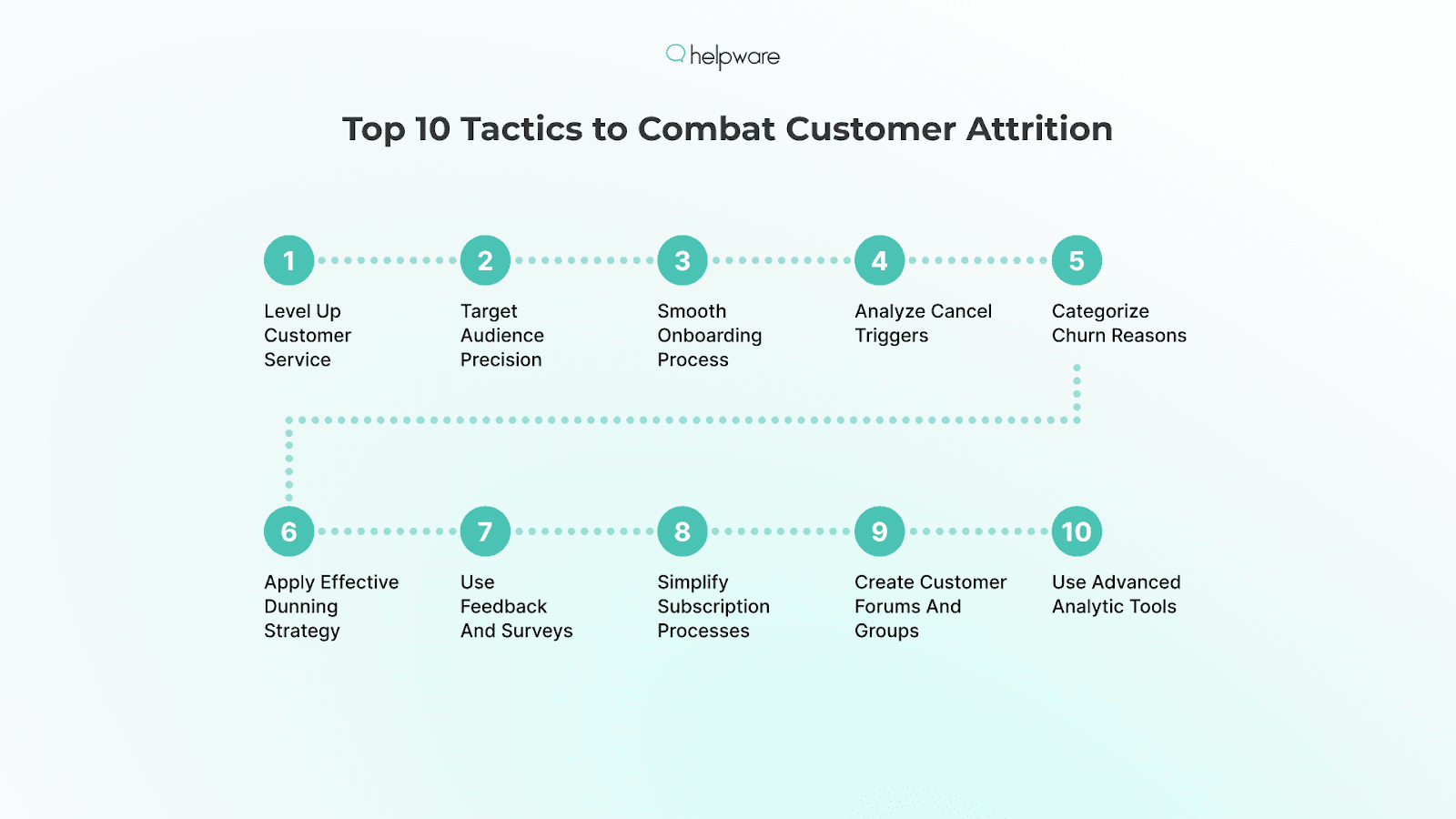What is customer churn? Why is it a critical issue for businesses? In commerce, this term represents the rate at which customers discontinue their relationship with a company or cease using its services or products.
It has become a serious concern for businesses. Put simply, the cost of acquiring new customers exceeds that of retaining existing ones. Moreover, a high churn rate diminishes revenue, undermines brand reputation, and impacts market stability.
Mitigating customer churn has emerged as one of the most crucial goals for many businesses. If you also aim for the same, this article will guide you through the essentials. We’ve curated the 10 top tips to reduce customer churn. Let’s start with the basics.
What Causes Customer Churn?
First and foremost, we should understand some factors that can cause customer churn. The three most crucial factors that drive customer discontinuation include product dissatisfaction, competitor attributions, and lifecycle changes. If you strive to keep your customer base strong and attract more new consumers, it’s important to see these affecting reasons. Before finding and addressing the factors, keep in mind that customer churn is often a multifaceted issue. By regularly gathering and analyzing customer feedback, businesses can stay ahead of many challenges and implement strategies to cope with them effectively.
Customer dissatisfaction
One of the primary triggers for churn is dissatisfaction. Whether it’s poor product quality, subpar customer service, or unmet expectations, dissatisfied customers are prone to seeking alternatives.
Customer dissatisfaction may also be the result of pricing options. There may be discrepancies between the value they receive and the price they pay. This could stem from inflexible pricing structures, unexpected fees, or more attractive competitors’ pricing.
Competitive market and better offers
Rival companies’ offerings or enticing promotions can lure customers away. Fierce competition often leads to customers exploring what competitors offer, potentially leading to churn.
Competitor attribution can occur for various reasons, such as superior offerings, enticing promotions, and market innovations from competitors. Factors like service differentiations and price competitiveness may also play a role. This is why many businesses make competitor analysis a huge part of their strategy and use web scraping API and XPath text contains to gather crucial data about their offerings, pricing structures, and marketing strategies. They can also leverage proxies for data gathering, but it’s recommended to consider the price of rotating proxies to ensure that the data collection process remains efficient and cost-effective.
Customer lifecycle changes
Customer churns only sometimes happen due to internal factors. In some cases, changes in customers’ lives or businesses, such as budget constraints, organizational shifts, or evolving needs, can prompt them to seek different solutions, contributing to churn.
Several factors can trigger these changes, including budget constraints, organizational shifts, and evolving needs. Customers may also experience changes in the market landscape, policy changes, environmental concerns, or geopolitical shifts, contributing to churn.
Measuring Customer Churn
How can you measure customer churn? You need to assess the rate at which customers leave. You can divide the number of customers lost during a specific period by the total number of customers at the beginning of that period.
Here’s an example: If a company starts with 500 customers and loses 50 within a month, the churn rate for that month would be 10% (50/500 * 100). So, you should aim for lower churn rates to maintain your business.
It’s essential to know how many customers your business loses every month and every year. The more details you gather during different periods of the year, the clearer the whole picture of this issue becomes. For instance, it can be a seasonal problem or related to specific market trends. Looking at how many customers you lose in busy times compared to quieter times can show if your business is affected by changes in the seasons. Also, getting to know the patterns in the market and how they change what customers do can help you figure out if the reason you’re losing customers is because of things happening outside your business or the way you run your business.
If you know all these things and details, you can start planning your new strategies for the next season. It’s also useful to compare your churn rate with industry benchmarks to understand where you stand competitively. Remember, a proactive approach to managing customer satisfaction can significantly reduce churn rates.
10 Tips to Reduce Customer Churn
Even though handling this issue can be challenging for brands, nothing is impossible. We’ve listed some of the best ways to reduce customer churn, from improving customer service to creating a customer community.
#1. Improve customer service
Customer service is essential in engaging existing customers. There are several points to make your customer service excellent, including response times, personalization, and multichannel support.
Identify how your customer service team handles customer problems. If you find room for improvement, you can find the solution immediately.
Typically, enhancing customer service involves providing prompt, helpful, and personalized assistance to address customer needs effectively, which encompasses various aspects.
Improve response time. Immediate responses to queries or issues showcase attentiveness and care. Also, strengthen your customer relationships by tailoring interactions based on individual preferences or past interactions.
Use multiple channels to connect with customers, such as email, call, and social media DMs. You can also use chatbots to assist customers around the clock.
#2. Focus on attracting targeted customers
Targeting specific audience groups is an effective strategy for reducing customer churn. Rather than casting a wide net, this strategy ensures that your marketing efforts resonate with the right audience.
First, understanding your target audience’s preferences, behaviors, and pain points guides marketing and product development. These insights also help you craft marketing messages relevant to the audiences.
Moreover, ensure you add value propositions to your product. Ensuring that your offerings align with what your targeted customers value maximizes their attraction to your brand.
#3. Offer a seamless onboarding
A smooth onboarding experience is crucial if you sell tech-based products like those in the SaaS and Fintech industries. Your products may have a learning curve, so assisting customers in their initial experience is essential.
Providing clear, step-by-step instructions helps customers navigate your product effectively. You can offer comprehensive support resources, such as explainer videos or FAQs, during the initial stages to reduce frustration and encourage continued usage.
Additionally, a personalized welcome experience tailored to individual preferences fosters a sense of belonging and investment. By focusing on an excellent onboarding process, your brand sets the stage for long-term customer satisfaction and loyalty.
#4. Analyze cancellation reasons
A comprehensive customer behavior analysis can help you identify and address pain points. Conducting meticulous data collection is necessary to understand when and why customers cancel subscriptions or discontinue using your service.
You can identify recurring patterns or commonalities among churned customers through rigorous analysis, pinpointing specific pain points. Consider using robust analytic tools, conducting surveys, and performing social listening to gain the insights that you need.
Based on the data, you can develop more accurate intervention strategies to handle the problem. Whether through product improvements, targeted marketing, or enhanced support at critical junctures, addressing these cancel points reduces churn and improves customer retention rates.
#5. Create classifications on cancellation reasons
Once you have identified the cancel points, continue with creating classifications. Here, you categorize the various motivations behind customer churn.
This strategy aims to systematize why customers cite when they cancel or discontinue a service. By categorizing these reasons into distinct classifications or groups, you can better understand the primary drivers of churn.
These classifications could also include categories like pricing concerns, product dissatisfaction, lack of features, customer service issues, or changes in circumstances. This systematic approach helps in addressing specific categories more effectively.
#6. Build an effective dunning strategy
A dunning strategy attempts to communicate with customers who have failed to make payments or renew subscriptions. An effective dunning strategy focuses on recovering potentially lost customers.
Several attempts are launched to engage customers, such as sending reminders, notifications, or incentives. These attempts encourage customers to renew or continue their subscriptions.
It’s important to note that this strategy should be well-timed and respectful. Also, it must provide solutions for customers to resolve payment issues or reconsider their decision to cancel. A well-crafted dunning strategy, facilitated by dunning management software, can maintain positive customer relationships.
#7. Survey customers and ask for feedback
Surveys and feedback are insightful resources to gain direct insights and delve into customer experiences. Surveys can also explore reasons for churn more comprehensively.
You can reach out to churned customers by giving them online surveys or feedback forms. You may also ask for what kind of solutions the customers are expecting. These insights help you understand customers’ perspectives and their reasons for discontinuation.
Consider constructing comprehensive surveys with open-ended questions and scaled responses to allow customers to articulate their experiences. This type of survey provides invaluable qualitative data that can highlight pain points and uncover patterns contributing to churn.
#8. Offer long-term subscriptions with a simplified process
Streamlining the subscription process is crucial in encouraging customers to commit to long-term relationships with a service or product. Is the process complicated? Are there steps to be eliminated or upgraded?
You’ll be able to answer those questions. If you find cancel points during the subscription process, it’s a sign for you to simplify it. You should minimize steps in the sign-up process, offer transparent pricing structures, and provide hassle-free renewal options.
By reducing barriers and complexities in subscription management, you can increase the likelihood of customers opting for long-term commitments. In return, churn rates associated with subscription discontinuations can be mitigated.
#9. Create a customer community
One of the best ways to listen to your customers’ experiences is through a customer community. You can provide platforms or spaces like forums, online groups, or social media communities, where customers can interact and share experiences.
This community fosters customer engagement, loyalty, and a sense of belonging. It’s also a valuable resource for customers seeking advice, troubleshooting, or engaging with like-minded individuals.
You can also gain valuable insights through this forum. It’s easier to listen to customers and provide tailored solutions whenever they have concerns. This strategy is also effective for improving the quality of your business’s customer service.
#10. Invest in robust subscription analytics
If you want to avoid the hassle of analyzing customer churn, incorporating subscription analytics can be an option. It can be a beneficial investment to understand customer behavior and subscription performance.
Moreover, sophisticated analytics tools provide insights into customer churn, acquisition, and retention metrics. Such tools help identify trends, predict churn risks, and understand the impact of various factors on subscription dynamics.
As a result, you can stay efficient in maintaining loyal customers and strengthening subscription models. You can make data-driven decisions, optimize pricing strategies, and address issues that may lead to churn.

Final Word
Minimizing customer churn is non-negotiable to maintain business growth and success. Retaining customers ensures long-term benefits for your business, including a stable revenue stream and better brand loyalty.
Implementing essential strategies, such as enhancing customer service, targeting specific audiences, and analyzing cancel points, provides a roadmap to fortify relationships and drive customer retention. These strategies address the root causes of churn.
The above tips on reducing customer churn help your business to adapt proactively to customer needs. A successful strategy to retain customers significantly outweighs the costs of acquiring new clientele, leading to better ROI.











